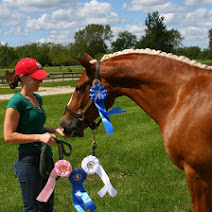 |
| I compulsively play with that particular curl. And I didn't shower this morning. You're welcome. |
1. Look at the top/first rail of the fence until it disappears between the horse's ears. Even if it was a combination, he wanted the rider to focus on the fence she wanted the horse to jump, not some future fence. It had to do with balance and conveying intentions. He said that you shouldn't look through the exercise, in a combination, the first element determines the second anyway so looking ahead isn't helping you.
2. Your foot position in the stirrup is going to be determined by your own conformation. Ahhh, there's nothing I like more than a good biomechanics discussion. He asked us to consider how we stand: most people stand with their feet underneath their center of gravity, slightly toed out. You won't be able to get your feet perfectly parallel to the horse's body if you're shaped like that.
3. Due to the technical nature of today's courses, the landing is the approach. He kept going back to this. He said that most fences today in a jumper round are part of a strided line rather than having long approaches, so your horse has to be immediately prepared to jump the next fence upon landing the previous fence. Throughout, he was adamant that the riders not continue to the next fence until they had a controlled canter that was suitable for the next jump. "Eventers are really bad about this..."
4. Regarding teaching babies to jump: He is okay with them getting "clobbered" by a fence if they're not paying attention, and wants them to make mistakes like that even if it's embarrassing for the rider. He says it's important to teach them that humans are "crazy" and will put things in their path that they are - gasp - forced to jump! Letting them make big mistakes like that helps create an alert horse. Similarly, there was a horse that wasn't used to the fences going up 6" inches at once and didn't give enough effort over the fence, and he said the same thing: the horse needs to be prepared for these crazy humans to put anything in his path, and he needs to be able to pay attention and adjust accordingly.
5. He disagrees with the idea that your horse needs to be rocked back on his hocks and "coiled like a spring" in order to jump effectively at smaller-ish fences. To argue his point, he pointed at the big hunter shows, where really nice horses travel along on almost no contact in a flat frame at "maaaybe 190mpm" and then proceed to jump 4' fences beautifully. Quote: "Put them back on their hocks so they can jump maybe 2'11? PLEASE!" He then noted that you have to know your animal and know what they're capable of, and that whoever said they needed to be coiled up like a spring had never looked at a horse before.
It was a fascinating introduction to him and his teaching methods, which I've never really delved into beyond the gymnastics book I own despite knowing full well he's one of the most important trainers in modern eventing. His ability to read each rider and pick their riding apart in a knowledgeable, entertaining, but non-derogatory way really resonated with the riders, and they all made noticeable improvements over the two hours. Very cool experience, I highly recommend auditing if you get a chance.




























Very interesting. Thanks for sharing!
ReplyDeletegreat post! Thanks for the "re-cap" :)
ReplyDelete#4 really resounds with me right now. In my lessons/trainer rides this has been something new that I have learned- I always thought that I needed to ride perfect to everything to give Henry the best experience and not a bad one... but my trainer corrected me, yes I need to ride well to every fence BUT the not so good spots and jumps teach Henry to either pay attention, listen better, prepare for what we are about to do.. etc.